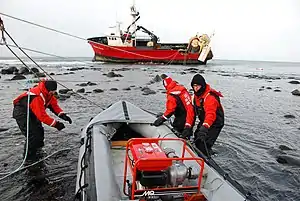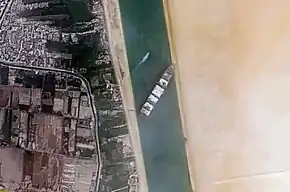Ship grounding
Ship grounding or ship stranding is the impact of a ship on seabed or waterway side.[1] It may be intentional, as in beaching to land crew or cargo, and careening, for maintenance or repair, or unintentional, as in a marine accident. In accidental cases, it is commonly referred to as "running aground".


When unintentional, grounding may result simply in stranding, with or without damage to the submerged part of the ship's hull. Breach of the hull may lead to significant flooding, which in the absence of containment in watertight bulkheads may substantially compromise the ship's structural integrity, stability, and safety.[2][3]
As hazard
Severe grounding applies extreme loads upon ship structures.[4] In less severe accidents, it might result only in damage to the hull; however, in most serious accidents, it might lead to hull breaches, cargo spills, total loss of the vessel, and, in the worst cases, human casualties.[5]
Grounding accounts for about one-third of commercial ship accidents,[6][7] and ranks second in frequency, after ship-on-ship collision.[8] Grounding accidents are being studied in many international ports with serious concerns, e.g. Chittagong Port in Bangladesh.[9]
Causes
Among the causes of unintentional grounding are:
Recovery
When accidental grounding occurs, the ship or its cargo, will need to be removed if possible. This is done for various reasons:
- The grounded ship remains seaworthy so the ship is removed in order to be repaired and return to service
- A stranded ship is unsightly
- A stranded ship experiences significant stress on its structure and will eventually become a shipwreck if not properly dealt with
- The ship contains hazardous material and can cause environmental damage if the material is released, which will eventually happen if stranded long enough
- A ship might be removed to prevent unauthorized entry into the ship by locals
- The grounded ship is a navigation hazard or otherwise obstructs a shipping route
See also
References
- Mazaheri, A., Montewka, J., Kujala, P., (2014), "Modeling the risk of ship grounding - A literature review from a risk management perspective", WMU-Journal of Maritime Affairs, Vol. 13, No.2, pp.269-297, doi:10.1007/s13437-013-0056-3
- Mazaheri, A., and Ylitalo, J., (2010), “Comments on geometrical modeling of ship grounding”, 5th International Conference on Collision and Grounding of Ships (ICCGS), June 14th - 16th, Espoo, Finland
- Montewka, J., Krata, P., Goerlandt, F., Mazaheri, A., Kujala, P., (2011), “Marine traffic risk modelling - an innovative approach and a case study”, Proceedings of the Institution of Mechanical Engineers, Part O, Journal of Risk and Reliability, Vol.225, No.3, pp.307-322, doi:10.1177/1748006X11399988
- Pedersen PT Collision and Grounding Mechanics. In: Proceedings of WEMT '95', Copenhagen, Denmark, 1995. The Danish Society of Naval Architecture and Marine Engineering
- Mazaheri, A., Goerlandt, F., Montewka, J., Kujala, P., (2012), “A decision support tool for VTS centers to detect grounding candidates”, International Journal of Marine Navigation and Safety of Sea Transportation, Vol.6, No.3, pp.337-343
- Kite-Powell HL, Jin D, Jebsen J, Papakonstantinou V, Patrikalakis N (1999) Investigation of Potential Risk Factors for Groundings of Commercial Vessels in U.S. Ports. International Journal of Offshore and Polar Engineering 9 (1):16-21
- Jebsen JJ, Papakonstantinou VC (1997) Evaluation of the Physical Risk of Ship Grounding. Massachusetts Institute of Technology,
- Samuelides MS, Ventikos NP, Gemelos IC (2009) Survey on grounding incidents: Statistical analysis and risk assessment. Ships and Offshore Structures 4 (1):55-68
- Mohammad Ehsan Khaled, Yasumi Kawamura, Mohammad Sayem Bin Abdullah, Arnob Banik, Abul Kalam Faruk, Mohammad Riad Khan, Assessment of Collision & Grounding Risk At Chittagong Port, Bangladesh, 11th International Conference on Marine Technology MARTEC 2018, UTM, Kuala Lumpur, Malaysia. https://www.mtc-utm.my/wp-content/uploads/MARTEC_2018_Paper/G2.pdf
- Briggs MJ, Borgman LE, Bratteland E (2003) Probability assessment for deep-draft navigation channel design. Coastal Engineering 48:29-50
- Fujii Y, Oshima R, Yamanouchi H, Mizuki N (1974) Some Factors Affecting the Frequency of Accidents in Marine Traffic: I- The Diameter of Evasion for Crossing Encounters, II- The probability of Stranding, III- The Effect of Darkness of the Probability of Collision and Stranding. The Journal of Navigation 27 (2):239-247
- Lin S-C (1999) Physical Risk Analysis of Ship grounding. Massachusetts Institute of Technology
- Quy N.M., Vrijling J.K., Gelder P.H.A.J.M. van, Groenveld R. (2006) On the assessment of ship grounding risk in restricted channels. Paper presented at The 8th International Conference on Marine Sciences and Technologies - Black Sea Conference, Varna, Bulgaria, September 25th-27th
- Amrozowicz MD (1996) The need for a probabilistic risk assessment of the oil tanker industry and a qualitative assessment of oil tanker groundings. Massachusetts Institute of Technology
- Amrozowicz MD (1996) The Quantitative Risk of Oil Tanker Groundings. Massachusetts Institute of Technology,
- Brown A, Haugene B (1998) Assessing the Impact of Management and Organizational Factors on the Risk of Tanker Grounding. Paper presented at the 8th International Offshore and Polar Engineering Conference
- Martins MR, Maturana MC (2010) Human error contribution in collision and grounding of oil tankers. Risk Analysis 30 (4):674-698
- Praetorius G (2012) Safety within the Vessel Traffic Service (VTS) Domain - Understanding the role of the VTS for safety within maritime traffic management. Chalmers University of Technology, Gothenburg